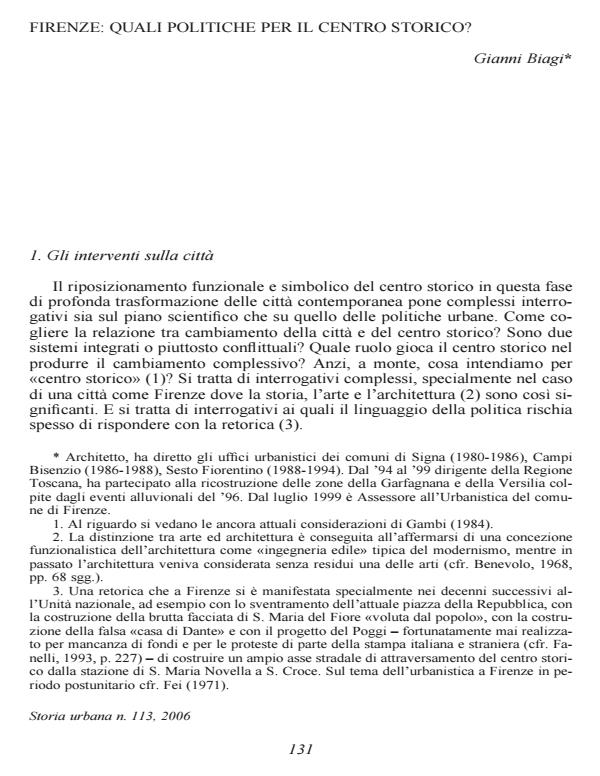Firenze: quali politiche per il centro storico?
Titolo Rivista STORIA URBANA
Autori/Curatori Gianni Biagi
Anno di pubblicazione 2007 Fascicolo 2006/113
Lingua Italiano Numero pagine 13 P. 131-143 Dimensione file 1876 KB
DOI
Il DOI è il codice a barre della proprietà intellettuale: per saperne di più
clicca qui
Qui sotto puoi vedere in anteprima la prima pagina di questo articolo.
Se questo articolo ti interessa, lo puoi acquistare (e scaricare in formato pdf) seguendo le facili indicazioni per acquistare il download credit. Acquista Download Credits per scaricare questo Articolo in formato PDF

FrancoAngeli è membro della Publishers International Linking Association, Inc (PILA)associazione indipendente e non profit per facilitare (attraverso i servizi tecnologici implementati da CrossRef.org) l’accesso degli studiosi ai contenuti digitali nelle pubblicazioni professionali e scientifiche
The author, currently head of Florence’s Office of Urban Planning, introduces a different conception of the historic center, no longer thought of, mechanically, as nothing more than the city enclosed within the walls demolished by Poggi in the second half of the nineteenth century. Today, the historic center can be better described as a series of parts that differ from each other, morphologically, socially and culturally, far more than they differ in these same respects from the surrounding urban areas outside the historic center. The city’s present administration has outlined a number of priorities for action: programs for relocating services and functions at the metropolitan scale; programs addressing infrastructures (and mobility in particular); specific urban planning initiatives targeting sensitive contexts. Relocating certain major functions in the urban fabric also makes it possible to revitalize the functions that remain in the historic center. Similarly, setting up a system consisting of the urban and metropolitan rail lines, the new LRV network and its connections with Florence’s new railway station will ease the pressure that automotive traffic now puts on the historic center, and link it with the areas earmarked for various important functions. As for specific urban planing initiatives targeting sensitive contexts, an interesting example is that provided by the San Lorenzo district, teetering on the line dividing crisis and growth. Here, the municipal administration has commissioned studies of the district’s economic and social situation, as well as a survey and interpretation of the district that provided input for the administration’s Structural Plan. In addition, the administration implemented a repurposing project that returned the privately owned areas of the former Cinema Apollo in Via Nazionale to public use, and initiated procedures for dealing with the Sant’Orsola complex, the true crux of the area.
Gianni Biagi, Firenze: quali politiche per il centro storico? in "STORIA URBANA " 113/2006, pp 131-143, DOI: